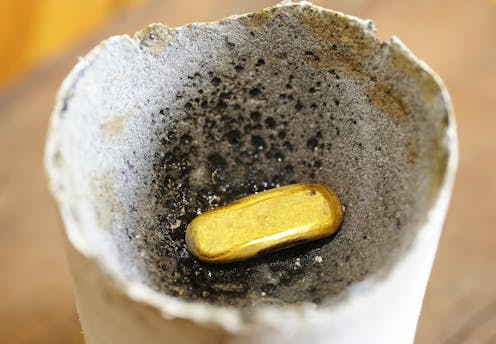How can you test if gold is pure? Some methods are more destructive than others
- Written by Michael Cortie, Professor emeritus, University of Technology Sydney

When it comes to gold, how pure is pure? And how does anybody know?
As recent revelations about the Perth Mint have shown, gold buyers and sellers take purity very seriously. Questions have been raised over impurities found in some A$9 billion worth of gold sold to the Shanghai Gold Exchange.
While the gold reportedly met the industry standard for 99.99% (or “4N”) purity, it failed to meet extra agreed specifications for the level of silver.
The question of testing the purity of gold has been a live one for thousands of years, with increasingly precise methods being devised. But despite these techniques, most of the time the gold industry still runs on trust and reputation.
A eureka moment
The ancient Greek mathematician Archimedes is said to have struck upon one way to test the purity of gold while getting into the bath.
The story goes that the king of Syracuse had asked the mathematician to determine whether a golden crown was made of the pure metal, or whether impurities had been mixed in by a dishonest goldsmith.
After thinking on the problem, Archimedes took a bath, and noticed that the level of the water rose when he stepped in. He leapt out immediately and ran into the street, crying “eureka!” (or “I’ve found it!”).
Read more: How gold rushes helped make the modern world
He had realised that submerging the crown in water would let him determine its volume, and hence its density. Because gold is denser than most other metals, this can be used to measure the crown’s purity.
There are debates about the historical accuracy of the tale, and the exact mechanism of the test he would have used, but the gist is in keeping with the principles Archimedes laid out in his treatise On Floating Bodies.
Fire and fluorescence
Despite the ingenuity of Archimedes’ method, it is not in use today. Some of the most common methods used in the modern gold industry are the fire assay, X-ray fluorescence, and inductively coupled plasma mass spectrometry (or ICP-MS).
The fire assay is the traditional method used in the hallmarking industry (to certify gold in jewellery as 9 carat or 18 carat, for example), and also often used in gold mines to test the quality of ore.
This is a destructive method, so it wouldn’t have worked for Archimedes. You take a small amount of metal from the item you’re testing, mix it up with various chemicals, and melt it down in a furnace or crucible.
Read more: From medicine to nanotechnology: how gold quietly shapes our world
The process is designed to remove everything except gold. So if you weigh the sample you put in and the gold you get out, you can figure out how pure the sample was.
However, the fire assay only tests for the amount of gold – it won’t tell you what else is in the sample.
Another common test (this one is non-destructive) involves X-ray fluorescence. You fire X-rays at the item you want to test, which excites the atoms in your sample and makes them spit out X-rays of different wavelengths. Analysing these wavelengths can tell you what’s in the sample. The machine will give you a readout telling you the amount of gold, silver, copper and so on.
The gold standard
To get real precision, there are several different, more elaborate tests you could try. In Australia, the “gold standard” would be what’s called inductively coupled plasma mass spectrometry (ICP-MS).
This process effectively vaporises a sample and then weighs the different atoms in it. It can tell you the composition of a sample with an accuracy of parts per billion.
It’s an expensive, bespoke process, though. You wouldn’t use it for jewellery. It’s mainly used by scientists, or mining companies that want to determine the exact composition of a sample.
You would typically only use this kind of testing if you had a great need for exactness, or a reason to be suspicious of a sample.
The importance of trust
In practice, these tests are not typically used by people buying gold. The gold industry largely runs on trust.
If a reputable seller tells you they’re giving you gold that is 99.99% pure, you generally believe them. You don’t test every coin or every bar.
For whatever reason (perhaps their extra conditions about silver content), the Shanghai Gold Exchange didn’t take the Perth Mint’s word about the purity of the gold it delivered.
Now the Perth Mint may have a trust problem. And when trust is broken, it’s not easily restored.
Authors: Michael Cortie, Professor emeritus, University of Technology Sydney





